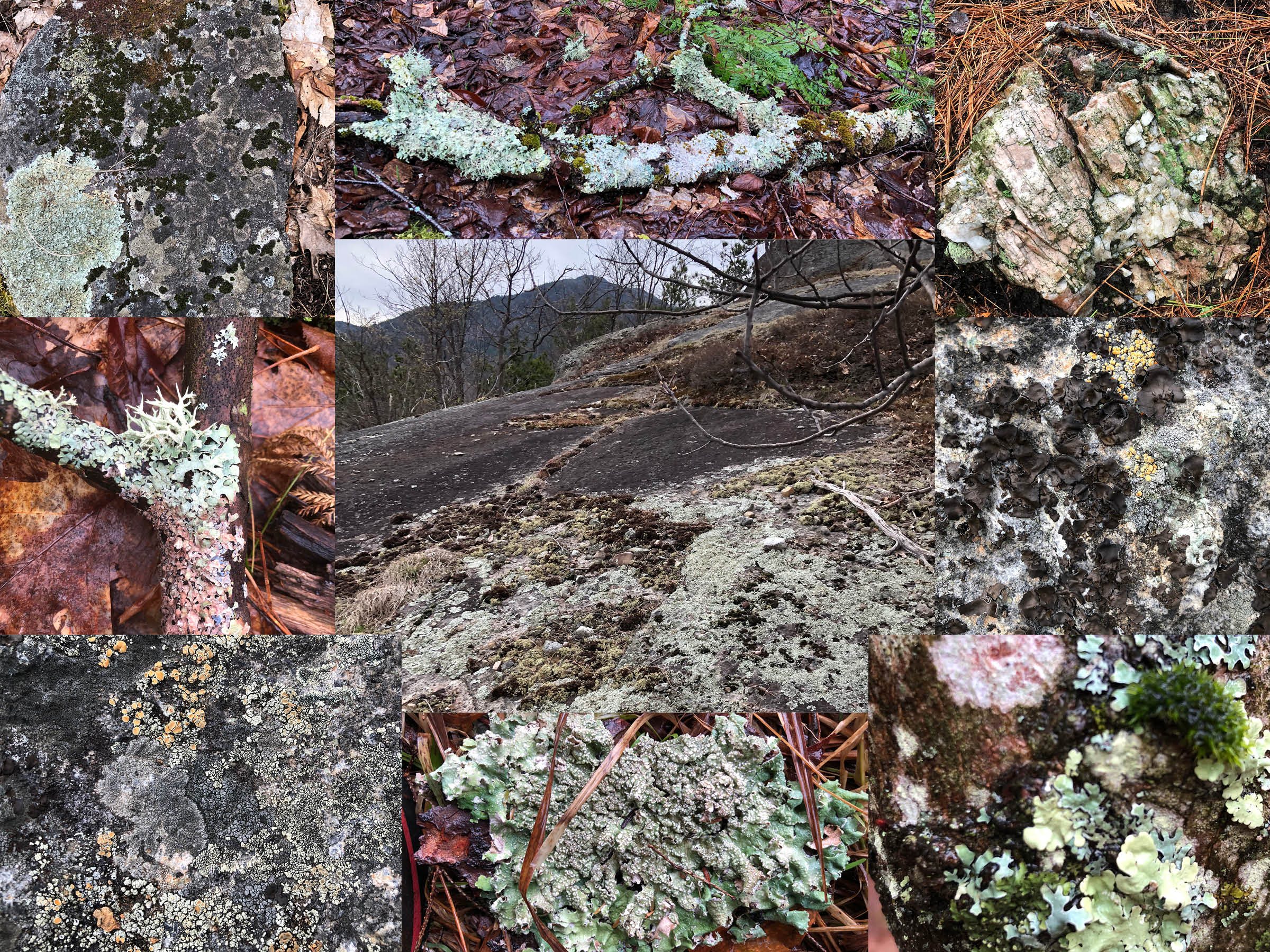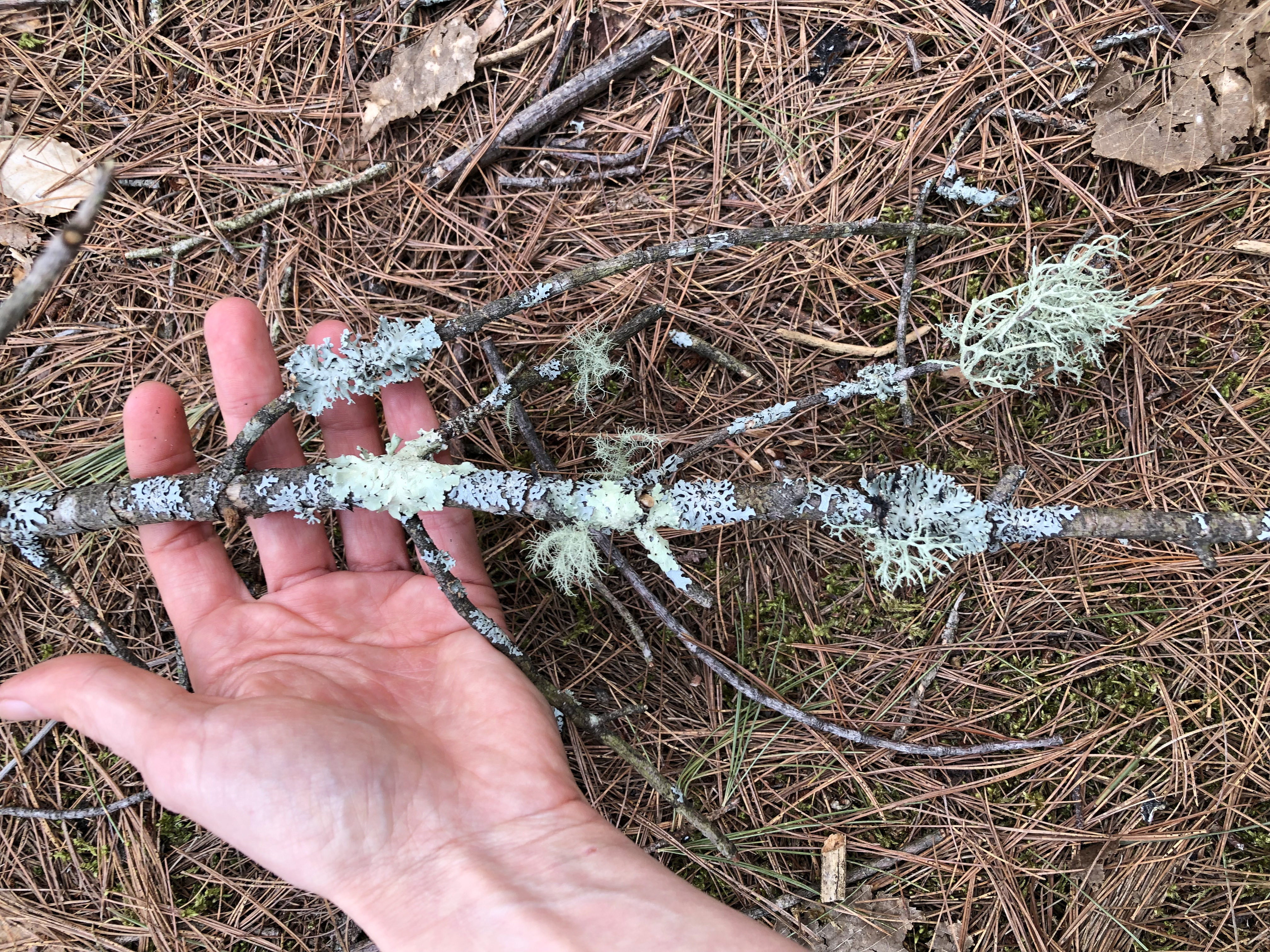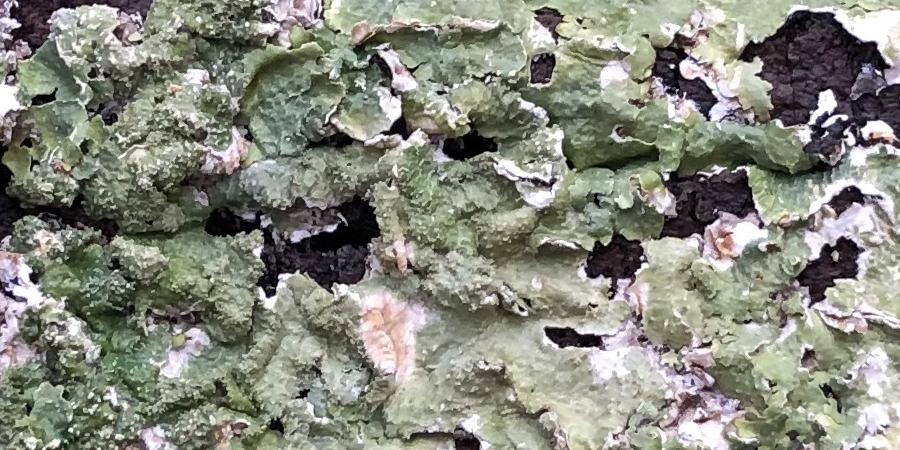It seemed like an unremarkable dreary day in the Adirondacks, wet and overcast. My hood was up and my eyes focused on the squishy ground beneath my feet. But the grey of the day was contrasted by the deep browns of the soil and bark at the base of tree trunks. The dead pine needles and leaf litter seemed to radiate warmth with their sienna, rust, sepia, fawn, and buttercream tones. My eyes were still low, drops of rain falling from the edge of my hood, but I caught a flash of what looked like technicolor seafoam green against the bark of a fallen log. I pushed back my wet hood and shifted my eyes toward the trail ahead. Mint and teal-colored medallions were suddenly everywhere; each tree trunk, bejeweled. Lichen.

Lichens on tree trunks along the trail.
The visual feast was impossible to ignore. I was mesmerized. I couldn't believe I was only just noticing them. Their structures felt delicate and succulent. I marveled at their shapes, felt the moisture on their surfaces, and recognized it within them too. I didn't know what they were, but I was hooked.
So I bought a reference book dedicated to them. My first interest was their physical appearance. There are thousands of species, with colors ranging from brilliant oranges to pale greens and textures just as varied: crusts, branches or cups, fanning leaf-like structures, sponges, even wispy beards. Walking through a forest during rain reveals a vast array of lichens as they absorb the water and appear more colorful and fluffy. They come back to life and their colors stand out against the wet and darkened surrounding. This relationship with water led me to want to know more.
Lichen is classified as part of the fungal kingdom. But lichens are so much more than any simple category or assumption. They are as unassuming as they are fascinating, easy to overlook or mistake for moss or algae. It's not a surprise that they're misunderstood, unknown, or ignored. They are not truly a single entity, but the symbiosis of lichenized fungi and green algae or cyanobacteria (blue-green algae). A botanist, Simon Schwendener, first proposed that lichens were not a single organism in 1869, arguing that the fungal partner provided protection and nutrients while the algal partner provided energy through photosynthesis and the processing of carbon dioxide.
Lichens can be found almost anywhere, except near sources of pollution. Because of their physical structure, they absorb everything through their outer layer or cortex, which means a lichen needs clean, fresh air to survive. They grow on a variety of surfaces, from rocks to insects. Lichens are indicators of air quality, because they absorb environmental elements so readily from rain and air. They are useful in monitoring pollution because of the intricacy of the lichen relationship between the fungus and the photosynthetic organism and their sensitivity to microclimates.

Lichens found on trees, rocks, fallen branches, and the forest floor.
Not only are lichens intricately beautiful pollution and climate indicators (just check out the US Forest Service's Lichen & Air Quality Database), they challenge our understanding of "relationship" and "individual." The very nature of an individual lichen, a convergence of two species, challenges how we think of evolution as a process of divergence. The lichenized fungus can reproduce by creating spores, but the algal partner isn't capable of reproducing. So the lichenized fungal spores have to find their own algal partner, or they will die. While each lichen is a relationship between two partners, they are not truly independent and can't survive or reproduce without each other. Lichens are able to survive in places where neither the fungus nor the algal partner could survive alone. A lichen is a relationship, but also an individual.
I like to think about this unlikely living arrangement as I walk through the woods and marvel at them. Fungus is primarily unseen in the woods, decomposing matter through threads underground. It is only seen when it sprouts a fruiting body, like a mushroom, to reproduce. Algae are primarily aquatic organisms. They don't have roots, stems, or leaves, but are capable of photosynthesis. Algae are unable to circulate water or nutrients throughout their bodies. But as a lichen, each is capable of behaving and existing in new ways. Both are exposed, out of the water and soil. Their relationship changes the nature of each individual and allows me to see their brilliant colors on the rocks and trees as I walk.
The term symbiosis was coined by botanist Albert Frank in 1877 to describe the lichen relationship. A relationship that blurs barriers between scientific kingdoms, requires a new idea of relationship, and forces us to reconsider what an individual is, makes lichen special. The physical beauty is what first drew me to them, but it's this concept of relationship, symbiosis, that has held my interest.

Fallen twig with several kinds of lichen found along a trail.
I've collected lichens on walks: bits shaken loose by wind to the forest floor, covering small twigs, and clinging to shreds of bark. This collection sits on the table by my bed and invites me to dream of the ways unlike things with different needs and abilities can come together for a common good. I think about the flowers I plant for the bees I'm allergic to and picture them pollenating my fruit trees, the plants in my garden, and other plants in these woods. The woodpecker pecking away at the dying cedar creates a hole as he carves out insects. He does not think of the hole's purpose once he is done with it, yet it makes an inviting home for other birds or flying squirrels. I'm reminded of the saplings on the edge of the trail, pruned by the deer during winter when food is scarce, and how those nibbled branches will sprout. We are different and our goals vary, but we contribute to the health of this ecosystem.
The converging relationship between fungi and algae to create lichens seem unlikely or even improbable. But they are a perfectly distilled example of ecology, natural cooperation, and communal harmony. They can be great teachers in expanding our notions of what it means to be an individual, create partnerships, and be in relationship with our surroundings.
Story by Madison Stroud, Operations Director.
Sign-up for our e-newsletter to get weekly updates on the latest stories from the Ausable River Association.

